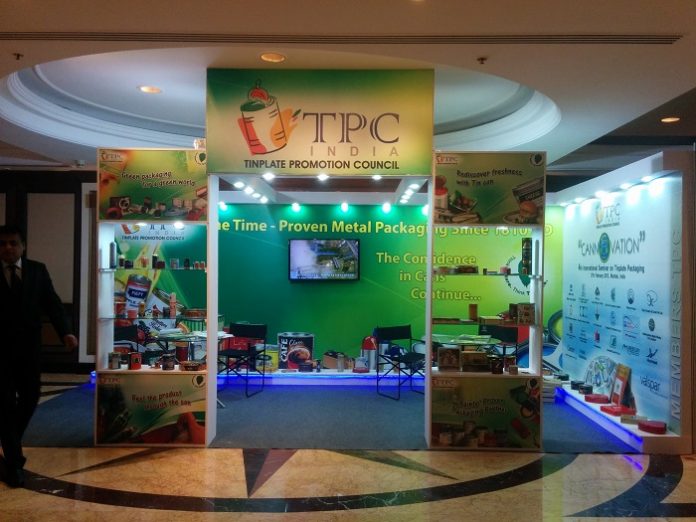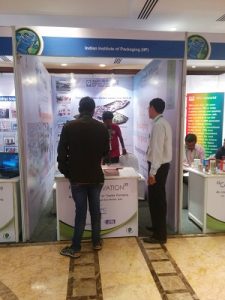
The Tinplate Promotion Council (TPC) held the fourth edition of Cannovation, one of the premier events in Asia on tinplate packaging at Taj Lands End on 27 February 2015. Cannovation is a medium to push reforms in the field of tinplate packaging. Abhesh Chatterjee, chief of marketing and sales, The Tinplate Company of India (TCIL) said, “It provides a common platform to brand owners, can makers, metal packaging technology providers and marketers, with a vision to create a meaningful interface on the current and future needs of the metal packaging industry.” He added, “We are sharing the technological problems in tinplate packaging and trying to promote tinplate as the most eco-friendly, cost-effective and sustainable packaging media for processed foods. In India per capita consumption of tin is very low as compared to developed economies. So far we have a positive response from visitors and 25% growth has been observed as compared to the last event.”
Tarun Daga, chairman, TPC and MD of TCIL kick-started the day-long event with his welcome address. Speaking about the merits of tin packaging, NC Saha, director, Indian Institute of Packaging (IPP) said, “It is the most adaptable sustainable packaging with exceptional barrier, aroma retention, high-impact resistance and is completely recyclable.” He also said that the tinplate industry has a growth of 6 to 7% annually in India.
Ramaiah Muthusubramanian, category packaging development director, Unilever said, “Tinplate is more relevant in today’s scenario for three reasons — it can be used as a reusable pack; it works well as a festive and promotional pack; and has a sustainable pack format.” Ashwani Kumar, chief technologist for packaging and graphics, ITC India, said that the packaging differs depending upon the region and stressed on seeing packaging from a customer’s point of view.
Innovations in metal packaging
Saket Bhatia, senior vice president, Hindustan Tin Works, expressed his gratitude to the TPC team and said that FSSAI guidelines and food safety issues emphasize the need for packaging but there is cut-throat competition, reduced margins and brilliant minds get absorbed into different sectors. He also said that converters should meet the decision makers, marketing members and communicate with them about innovation in metal packaging. Ease of opening and downgauging the thickness will make it more preferable as a packaging material in food and non-food products. He talked about inks which are well-known but not seen much in the market, that is, thermographic and glow in dark inks highlighting the brands. He also discussed about Rajniganda tin as an innovative package by the company and mentioned its tagline, “Jab dusro ke khawab purre karoge to apna kal bante dekhoge — so let’s work for them (clients) and build our own future.”
Jeremy Pearce, ITRI technology team leader, gave an introduction about tin packaging and said, “Canned food has better nutrition for our children. A huge amount of fresh foods are produced in India but about 40% of fresh foods in this country is wasted. It never reaches the consumer, because it is perishable and never gets transported, which is shocking. This is partly due to culture — only 3 % of the food is sold through modern retail outlets, 97% is sold through traditional methods. However, the solution is very simple — robust containers containing nutritious foods can be transported anywhere.” Jeroen Ruoff, director, and Simone Vooijs, technical director of Tata Steel Packaging, Europe introduced a new package, Protact, which combines the robustness of steel with the versatility of plastic providing an even more efficient material for the can.

Companies such as Akzo Nobel, PPG coatings, Valspar and Fuji Kikai Kogyo had video presentations to showcase the different services they can provide in metal decoration and coating technology. Shubhenjit Chaudhuri, chief of corporate sustainability, Tata Steel, shared few facts about the extinction of resources in the world in the next 50 years. Ashok Ghosh, secretary general of the Indian Tinplate Manufacturers Association gave a brief overview about ideal sustainable packaging and introduced the ISO 18600 series to provide guidelines and a framework to integrate environmental concerns in the development of a sustainable packaging system.
Vishal Ingale, section head of packaging development for Pidilite said that he visited the event in order to meet converters and interact with them regarding technical issues. In Pidilite, around 10 to 15% products are in tins but to acquire more products, cost is a factor which needs to be considered.
The fruition of the event is credited to the initiative and support provided by the IIP and International Tin Research Institute (ITRI) who joined hands with TPC and hosted the convention.











